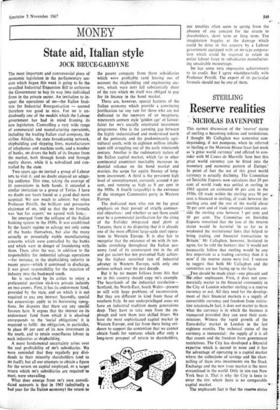Reserve realities
STERLING -NICHOLAS DAVENPORT
This earnest discussion of the 'reserve' status of sterling is becoming tedious and tendentious. I thought Mr Callaghan was somewhat con- descending, if not pompous, when he referred to sterling at the Mansion House feast last week as 'a great world currency' and offered to con- sider with M Couve de Murville 'how best this great world currency can be fitted into the monetary and economic pattern of Europe.' In point of fact the use of this great world currency is actually declining. The Committee on invisible Exports now calculates that 29 per cent of world trade was settlen in sterling in 1965 against an estimated 40 per cent in the 1930s. Of trade within the sterling area 90 per cent is financed in sterling, of trade between the sterling area and the rest of the world about 70 per cent and of trade amongst countries out- side the sterling area between 5 per cent and 10 per cent. The Committee on Invisible Exports remarked that the loss of the reserve status would be harmful 'in so far as it weakened the institutional links that helped to bring trading and financial transactions to Britain.' Mr Callaghan, however, hesitated to agree, for he told the bankers that 'it would not necessarily follow that sterling would be any less important as a trading currency than it is now' if the reserve status were lost. I venture IQ suggest that both Mr Callaghan and the committee are not facing up to the facts.
should be made clear—one pleasant and Thro-other unpleasant. First, it does not com- mercially matter to the financial community in the City of London whether sterling is a reserve currency or not. All they need for the develop- ment of their financial markets is a supply of convertible currency and freedom from restric- tive taxation. In fact, it does not matter to them what the currency is in which the business is transacted provided they can earn their com- missions. Witness the rapid growth of the Euro-dollar market in London in the last eighteen months. The technical status of the currency is immaterial: the supply of it is all that counts and the freedom from government restrictions. The City has developed a financial expertise which is second to none and it has the advantage of operating in a capital market where the collections of savings and the chan- nelling of them into investments via the Stock Exchange and the new issue market is the most streamlined in the world. Only in size can New York beat it. That is why the City is keen to enter the EEC where there is no comparable capital market.
The unpleasant fact is that the reserve status
4**
of sterling is costing us a pretty penny. This is the only conclusion which can be drawn from the official figures of the sterling balances. A year ago (September 1966) central monetary institutions abroad (excluding the ow) held £2,706 million in sterling balances in London and if they were then receiving interest at the Treasury bill rate of over 61 per cent— Bank rate then being 7 per cent—they were mulcting us to the tune of about £180 million. An item of this size could easily put us into the payments red in a difficult trading year like 1967. Fortunately the scares and alarms of 1967 have frightened some of these central monetary institutions into reducing their sterling balances. At the end of June, according to the official record, their holdings had fallen to £2,268 mil- lion and, Bank rate then being 51 per cent, the Treasury bill rate had fallen to 51 per cent. But it is still a costly affair.
I cannot understand what the Chancellor meant when be told the feasting bankers last week : 'Nobody planned or created the steiling area.' When the £ was pushed off its gold pedestal in 1931 and was allowed to fluctuate in market value those countries which had fol- lowed sterling in its divorce from gold began to work together deliberately as a currency bloc. As the world depression deepened there was an increasing distrust of the dollar and an increas- ing confidence in a well-managed pound. There was even talk of a sterling standard-to replace the old gold standard. But this dream warshattered in 1939. On the outbreak of war the floating sterling exchange rate came to an abrupt end The non-Commonwealth members left the sterling area and a new fixed rate of exchange with the dollar at $4.03 was put into operation for the £. There it remained until Cripps devalued it to $2.80 in 1949.
The sterling area during the war was clearly defined and legalised as 'the scheduled ter- ritories' ithm the Commonwealth—except Canada—plus Egypt, Sudan and Iraq). Rigid exchange controls were put into force in each member country and surplu foreign ex- change earnings were paid over to the Bank of England which managed a central dollar pool. The pool is still working but more loosely. Unfortunately the huge sterling credits which the Commonwealth and other countries built up during the war remained (the sterling area system had tacilitated their creation) and these sterling balances have given sterling the status of a so-called 'reserve' currency. How to re- duce them or fund them at a lower rate of in-- terest is the great problem of the UK as banker. But how Mr Callaghan can claim that the sterling area 'developed like other market in- stitutions by an impersonal process with the growth of world trade' is beyond me.
If only Lord Chalfont at his off-the-record talk in Lausanne had really threatened to do • what President de Gaulle had suggested— withdraw sterling from its role of a reserve currency!











































 Previous page
Previous page